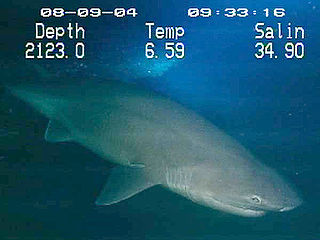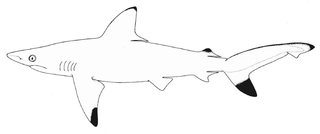
The Hexanchiformes are the order consisting of the most primitive types of sharks, and numbering just seven extant species. Fossil sharks that were apparently very similar to modern sevengill species are known from Jurassic specimens.

Cow sharks are a shark family, the Hexanchidae, characterized by an additional pair or pairs of gill slits. Its 37 species are placed within the 10 genera: Gladioserratus, Heptranchias, Hexanchus, Notidanodon, Notorynchus, Pachyhexanchus, Paraheptranchias, Pseudonotidanus, Welcommia, and Weltonia.

Chlamydoselachus is a genus of sharks and the sole extant member of the family Chlamydoselachidae, in the order Hexanchiformes. It contains two extant and several extinct species. The most widely known species still surviving is the frilled shark. It is known as a living fossil, along with Chlamydoselachus africana, also known as the southern African frilled shark, which is only found along coastal areas of South Africa. The only two extant species of this genus are deep-sea creatures which are typically weakened in areas closer to the surface.

Samuel Walton Garman, or "Garmann" as he sometimes styled himself, was a naturalist/zoologist from Pennsylvania. He became noted as an ichthyologist and herpetologist.

Xenacanthidae is a family of prehistoric sharks in the order Xenacanthida.

The hardnose shark is a species of requiem shark, in the family Carcharhinidae, so named because of the heavily calcified cartilages in its snout. A small bronze-coloured shark reaching a length of 1.1 m (3.6 ft), it has a slender body and a long, pointed snout. Its two modestly sized dorsal fins have distinctively elongated rear tips. The hardnose shark is widely distributed in the western Indo-Pacific, from Kenya to southern China and northern Australia. It inhabits warm, shallow waters close to shore.

The Pondicherry shark is an extremely rare species of requiem shark, in the family Carcharhinidae. A small and stocky gray shark, it grows not much longer than 1 m (3.3 ft) and has a fairly long, pointed snout. This species can be identified by the shape of its upper teeth, which are strongly serrated near the base and smooth-edged near the tip, and by its first dorsal fin, which is large with a long free rear tip. Furthermore, this shark has prominent black tips on its pectoral fins, second dorsal fin, and caudal fin lower lobe.

The brownspotted catshark is a rare catshark of the family Scyliorhinidae, found in the Indo-West Pacific between latitudes 11° N and 12° S. Its juvenile length is about 38 cm, but its adult size is mostly unknown. The reproduction of this catshark is oviparous. The specific name garmani was dedicated to Samuel Walton Garman (1843–1927), renowned herpetologist and ichthyologist of the Museum of Comparative Zoology of Harvard University.

The African sawtail catshark is a species of catshark, part of the family Scyliorhinidae. Demersal in nature, it is found at depths of 160–720 m (520–2,360 ft) off the western African coast from Morocco to South Africa. This slender species has a rather long, pointed snout, a series of dark saddles along the back and tail, and a prominent crest of enlarged dermal denticles along the upper edge of the caudal fin. Its maximum known length is 46 cm (18 in).
Count Jefferson von Pfeil und Klein-Ellguth is the son of German Count Friedrich-August Rüdiger Albrecht von Pfeil und Klein-Ellguth and Astrid Maria Andres. By birth he is a member of an ancient House of Pfeil und Klein-Ellguth which can trace their noble ancestry way back to 12th century.
The raspy river stingray, mosaic stingray or arraia is a species of freshwater fish in the family Potamotrygonidae. This stingray is endemic to the Amazon basin in Brazil, where known from the Amazon–Pará River, the Madeira River basin, Uatumã River and lower Tocantins River.
C. africana may refer to:
Proteothrinax baumgartneri is an extinct species of shark. It was classified based on two relatively complete teeth and two isolated crowns, described from the Eocene (Lutetian) Weitwies Subformation in Austria. Due to the limited material available and its similarities to Chlamydoselachus fiedleri, it has been suggested that the criteria with which P. baumgartneri is separated from Chlamydoselachus fiedleri are within the normal variation of Chlamydoselachus. This would therefore make P. baumgartneri a junior synonym to Chlamydoselachus fiedleri and, since there is only one identified species within genus Proteothrinax, the whole genus a junior synonym to Chlamydoselachus.
Thrinax is a genus of plants in the palm family (Arecaceae). Thrinax may also refer to:

The Nusplingen Limestone is a geological formation in Baden-Württemberg, Germany. It preserves fossils dating to the Kimmeridgian age of the Late Jurassic. It mainly consists of lithographic limestones deposited in a marine basin, similar to the Solnhofen Limestone. Fossils of pterosaurs, thalattosuchians, and the oldest geophilomorph centipede Eogeophilus were found in the Nusplingen Limestone.

Friedrich Wilhelm Leopold Pfeil was a German forester.
Rolfodon bracheri is an extinct species from the family Chlamydoselachidae. It lived during the Miocene.
Rolfodon goliath is a species of large frilled shark that lived during the Late Campanian stage of the Late Cretaceous in Angola's southern Benguela Basin. It was described by Miguel Telles Antunes and Henri Cappetta in 2002 during the beginning stages of the PaleoAngola project. Originally it was described as a species belonging to the genus Chlamydoselachus; Cappetta, Morrison & Adnet (2019) transferred it to the chlamydoselachid genus Rolfodon.

Ulrich Pfeil is a German historian based in France.










